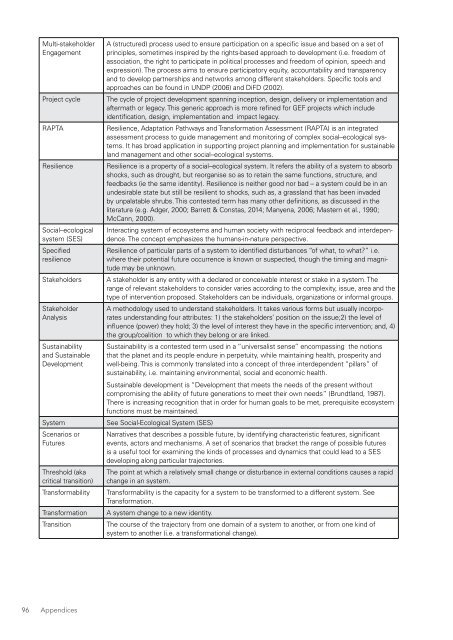DESIGNING PROJECTS IN A RAPIDLY CHANGING WORLD
srun3013fp1
srun3013fp1
Create successful ePaper yourself
Turn your PDF publications into a flip-book with our unique Google optimized e-Paper software.
Multi-stakeholder<br />
Engagement<br />
Project cycle<br />
RAPTA<br />
Resilience<br />
Social–ecological<br />
system (SES)<br />
Specified<br />
resilience<br />
Stakeholders<br />
Stakeholder<br />
Analysis<br />
Sustainability<br />
and Sustainable<br />
Development<br />
System<br />
Scenarios or<br />
Futures<br />
Threshold (aka<br />
critical transition)<br />
Transformability<br />
Transformation<br />
Transition<br />
A (structured) process used to ensure participation on a specific issue and based on a set of<br />
principles, sometimes inspired by the rights-based approach to development (i.e. freedom of<br />
association, the right to participate in political processes and freedom of opinion, speech and<br />
expression). The process aims to ensure participatory equity, accountability and transparency<br />
and to develop partnerships and networks among different stakeholders. Specific tools and<br />
approaches can be found in UNDP (2006) and DiFD (2002).<br />
The cycle of project development spanning inception, design, delivery or implementation and<br />
aftermath or legacy. This generic approach is more refined for GEF projects which include<br />
identification, design, implementation and impact legacy.<br />
Resilience, Adaptation Pathways and Transformation Assessment (RAPTA) is an integrated<br />
assessment process to guide management and monitoring of complex social–ecological systems.<br />
It has broad application in supporting project planning and implementation for sustainable<br />
land management and other social–ecological systems.<br />
Resilience is a property of a social–ecological system. It refers the ability of a system to absorb<br />
shocks, such as drought, but reorganise so as to retain the same functions, structure, and<br />
feedbacks (ie the same identity). Resilience is neither good nor bad – a system could be in an<br />
undesirable state but still be resilient to shocks, such as, a grassland that has been invaded<br />
by unpalatable shrubs. This contested term has many other definitions, as discussed in the<br />
literature (e.g. Adger, 2000; Barrett & Constas, 2014; Manyena, 2006; Mastern et al., 1990;<br />
McCann, 2000).<br />
Interacting system of ecosystems and human society with reciprocal feedback and interdependence.<br />
The concept emphasizes the humans-in-nature perspective.<br />
Resilience of particular parts of a system to identified disturbances “of what, to what?” i.e.<br />
where their potential future occurrence is known or suspected, though the timing and magnitude<br />
may be unknown.<br />
A stakeholder is any entity with a declared or conceivable interest or stake in a system. The<br />
range of relevant stakeholders to consider varies according to the complexity, issue, area and the<br />
type of intervention proposed. Stakeholders can be individuals, organizations or informal groups.<br />
A methodology used to understand stakeholders. It takes various forms but usually incorporates<br />
understanding four attributes: 1) the stakeholders’ position on the issue;2) the level of<br />
influence (power) they hold; 3) the level of interest they have in the specific intervention; and, 4)<br />
the group/coalition to which they belong or are linked.<br />
Sustainability is a contested term used in a “universalist sense” encompassing the notions<br />
that the planet and its people endure in perpetuity, while maintaining health, prosperity and<br />
well-being. This is commonly translated into a concept of three interdependent “pillars” of<br />
sustainability, i.e. maintaining environmental, social and economic health.<br />
Sustainable development is “Development that meets the needs of the present without<br />
compromising the ability of future generations to meet their own needs” (Brundtland, 1987).<br />
There is increasing recognition that in order for human goals to be met, prerequisite ecosystem<br />
functions must be maintained.<br />
See Social-Ecological System (SES)<br />
Narratives that describes a possible future, by identifying characteristic features, significant<br />
events, actors and mechanisms. A set of scenarios that bracket the range of possible futures<br />
is a useful tool for examining the kinds of processes and dynamics that could lead to a SES<br />
developing along particular trajectories.<br />
The point at which a relatively small change or disturbance in external conditions causes a rapid<br />
change in an system.<br />
Transformability is the capacity for a system to be transformed to a different system. See<br />
Transformation.<br />
A system change to a new identity.<br />
The course of the trajectory from one domain of a system to another, or from one kind of<br />
system to another (i.e. a transformational change).<br />
96 Appendices


